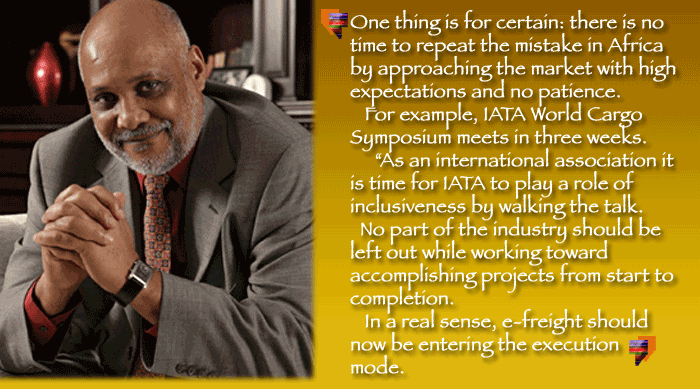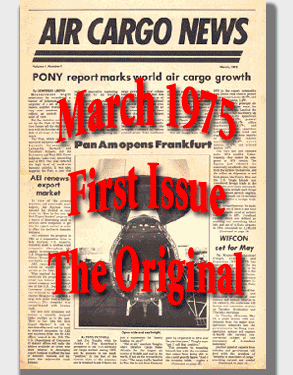 |

#INTHEAIREVERYWHERE |
|
|
Vol. 12 No. 18 THE GLOBAL AIR CARGO PUBLICATION OF RECORD Tuesday February 19, 2013 |
 |
|
 |

The first is Open
Sky policy.
With just a few
exceptions, Africa still applies very strict landing
rights that are archaic in nature and designed
to protect their small airlines.
These restrictions
are one of the major bottlenecks to growth as
it suffocates imports and exports of the local
produce.
Just look, for example,
to Kenya that has developed into a leader in cut
flowers because of their Open Sky policy.
Elsewhere, Egypt
is a top exporter of green beans because of the
right policies. Ghana is on top because of pineapples
and allowing airlines and charter operators to
fly in/out easily.”

The second item
that needs to be addressed if the Africa market
is to move ahead is the need to open up secondary
airports to relieve the main airports from pressure
and to develop other regions of the continent.
Just look at the
numbers:
Of the 56 countries
in Africa, about 53 delivered positive GDP in
2012 and have done so consistently during the
past 3 years.
Consumer goods are
anticipated to reach a trillion dollars by 2020
for a growing African middle class estimated at
350 million.

Worth mentioning
as well is that in almost every country there
are ample supplies of either gas, oil, or both
as well as vast real estate packed with minerals.
Africa indeed is
the last economic frontier.
The main stars moving
ahead in my opinion are Ghana, Botswana, Rwanda,
and Tanzania.

Right now political
stability and the right policies are taking these
countries into double-digit growth.
And there are 33
other African countries that now have multi-party
political systems and have held elections.
So things are changing.
The elections in
Ghana in December of 2012 were historic.
Very peaceful and
the message across the country was clear: ballots
and not bullets.

Opening up the African
market top to bottom will require a massive influx
of trained specialists be brought to the fore.
The hope is that
conferences, such as Air Cargo Africa this week
in Johannesburg, will raise this issue.
Personally I would
like to see various international and also local
African associations cooperate in tackling the
issue of training.
The internationals
can help in the trainers programs so that local
associations can move forward in devising apprenticeship
programs.
Multi-nationals
are moving into Africa in a big way.
They should look
at supporting the local associations which exist
in virtually every country.
One thing is for
certain: there is no time to repeat the mistake
in Africa by approaching the market with high
expectations and no patience.
For example, IATA
World Cargo Symposium meets in three weeks.
As an international
association it is time for IATA to play a role
of inclusiveness by walking the talk.
 No
part of the industry should be left out while
working toward accomplishing projects from start
to completion.
No
part of the industry should be left out while
working toward accomplishing projects from start
to completion.
In a real sense,
e-freight should now be entering the execution
mode.
Geoffrey
Editors Note: Issa Baluch may know as much
about logistics as anybody you ever met.
He has the chops
and know-how gained over a career that spans 37+
years, so when he puts his thoughts down in black
in white for the rest of us, it’s our duty
to study and ponder what he has to say.
The Baluch book,
Transport
Logistics - Past, Present and Predictions,
(available on Amazon for $65.US ) is a 300-plus-page
barnburner that Prof. Issa created in 2005, and
it still fascinates.
Who else sets the
table for modern logistics study with detailed
examples of historic projects that demanded careful
transport logistics management? Examples include
what it took to build the Great Pyramid in Egypt,
and transport logistics practiced in the Berlin
Airlift and at the Battle of Stalingrad.
A second volume,
The
Wheels of Commerce (Amazon $36.50) was created
last October (with Charles Edwards) and follows
the thread in an additional 340 pages.
Best known as the
founder of Dubai-based Swift Freight, a medium-sized
multi-national that was eventually sold to Barloworld,
Issa has made several lasting contributions to
the world of logistics, including his position
as the guy who launched sea-air in Dubai.
These days in some
kind of “retirement”(as if he ever
could be), Issa is now teaching at Harvard and
involved in projects at MIT, where he is undoubtedly
thinking big thoughts about logistics whilst occasionally
appearing at conferences to lend his expertise
and passion.
Issa is also involved
in a major farming initiative in Ghana, which
is a whole “nother story” as it is
said, so stay tuned.
It is incredibly
important and invaluable for every stakeholder
in air cargo to have Issa’s take on Africa.
He is timely and
ahead of his time, and always, as his friend Ram
Menen describes, “a nice guy.”
We heartily second
that notion.
 |
 |
Saudia
Cargo said it moved 516,000 tons in 2012, scoring
a 21 percent increase in revenue versus 2011. |
| |
|

A number of airlines
including Saudia Cargo took the opportunity to
shift capacity out of China once the Lunar New
Year celebrations began, just in time to hit the
peak flower season ex-South America and Africa
into Europe for St Valentine’s Day. But
once output from China’s factories fully
resumes in late February inventory restocking
could prompt another mini-boom in air freight
demand ex-China.

On the shipping
side of the transport equation, lines have taken
rather hearty measures to keep freight rates stable.
To cope with the
deathly quiet loading season in China carriers
announced a series of capacity cuts and blank
sailings. Maersk, for example, suspended one of
its Asia-Europe loops until April due to “declining
demand”.
Other leading liner
executives have spoken about the need to maintain
disciple to sustain freight rates at profitable
levels.
Many are pinning
hopes on a series of major General Rate Increases
announced on the Asia-Europe trade starting early
to mid-March and ranging from $600-800 per TEU.
Whether they can force through the hikes remains
to be seen.
Analysis from ACM/GFI
shows that rates are already far higher than a
year earlier despite vessel slot capacity availability
being more plentiful.

ACM/GFI says the
liner shipping paper market reveals weak forward
sentiment towards the March GRIs, but there is
more evidence that this year companies are planning
for a traditional Q3 peak season in freight rates,
something that has largely failed to materialize
over the last two years.
The Transpacific
Stabilisation Agreement (TSA) which represents
most major carriers on the route has also recommended
GRIs starting April of $400/FEU and $600/FEU for
shipments from Asia to the US West Coast and East
coast, respectively. The ‘G6’ alliance
of carriers (Hapag Lloyd, NYK, OOCL, APL, HMM
and MOL) which was set up last year to aid co-operation
on Asia-Europe lanes has now been extended to
the Transpacific, suggesting carriers are extending
effort to manage capacity.
“If nothing
else, these latest announcements point to further
commoditisation on the Transpacific head haul
trade,” said ACM/GFI. “While carriers
are still free to co-ordinate rate hikes whenever
they choose, albeit via a thinly veiled consortium,
they do so despite market fundamentals, and at
the same time as aligning their service offerings.”

On the plus side,
it seems the threat of strike action at U.S. ports
and congestion surcharges has given greater certainty
to U.S. shippers after USMX and ILA reached agreement
on a master contract valid for six years.
 Of
course, the fate of freight rates also depends
on the strength of the global economic recovery.
Initial signs in early 2013 suggest financial
conditions are improving and policy actions are
providing stability.
Of
course, the fate of freight rates also depends
on the strength of the global economic recovery.
Initial signs in early 2013 suggest financial
conditions are improving and policy actions are
providing stability.
“The global
economy remains on the expansionary track at the
start of 2013,” said Peter Sand, BIMCO Chief
Shipping Analyst. “The positive development
is underpinned by rising global employment, a
faster new order inflow and a higher output of
services and manufactured goods.
“Most major
economies contributed to the composite Purchasing
Managers Index’s (PMI) growth. As global
manufacturing PMI is a leading indicator for global
industrial production, which is closely linked
to shipping demand, BIMCO see this overall improvement
as a support to shipping.” And, he may have
added, for air cargo too.
World output will
jump from 3.2% in 2012 to 3.5% this year, according
to IMF January projections.
Sand said that for
container shipping the demand situation looked
rather solid and “underpins the optimism
that also originates from a lower inflow of tonnage
as the year progresses”.

Nevertheless, this
year there will be asteady procession of new Ultra
Large Containerships joining the fleet which will
be the largest on the High Seas once they are
launched in late Spring and early summer.
After some 51 vessels
of more than 10,000 TEU capacity were added to
the fleet last year, another 42 will be introduced
in 2013.
“The impact
from this will be felt in particular on the Far
East to Europe trading lane, where these vessels
are almost exclusively heading,” said Sand.
“This will mean that a bit more than 4 full
strings of 10 vessels each will be added.”
Although demand
growth continues to be outstripped by supply expansion,
January was the most active month on record for
container ship recycling, behind only two months
in mid-2009, providing some ballast to market
sentiment.
“At the beginning
of 2010 and again in 2012 rates went up from low
levels to double up and quadruple up, bringing
around a freight rate level that left room for
subsequent rate slides throughout the rest of
the year within healthy distance of break-even
levels,” said Sand. “2011 was very
different, but 2013 has started along the positive
lines of 2010 and 2012.”
“If history
is anything to judge by, the freight rate lifts
that have been experienced on the trans-Pacific
and Far East to Europe trades in recent weeks
may bring about rather decent average full-year
rates.”
Sky King
 |
|
If
You Missed Any Of The Previous 3 Issues Of FlyingTypers
|
|||||
|
|||||
FT021213 |
FT021913 |
||||
|---|---|---|---|---|---|
Publisher-Geoffrey
Arend • Managing Editor-Flossie Arend • Associate
Publisher/European Bureau Chief-Ted Braun Film Editor-Ralph Arend • Special Assignments-Sabiha Arend, Emily Arend • Advertising Sales-Judy Miller |
|



 Good to see Johannesburg
as the venue for Air Cargo Africa this week, but
from my point of view a part of South Africa is
still living under sanctions of the past.
Good to see Johannesburg
as the venue for Air Cargo Africa this week, but
from my point of view a part of South Africa is
still living under sanctions of the past. 



 When
he was 70 years old, the great playwright, author,
singer, and film director extraordinaire Noel
“Cad” Coward observed:
When
he was 70 years old, the great playwright, author,
singer, and film director extraordinaire Noel
“Cad” Coward observed:

